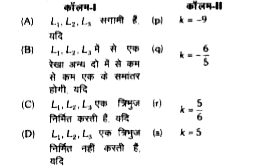यदि तो
0
25
625
इनमे से कोई नहीं
The correct Answer is:D
Step by step video, text & image solution for यदि D_(p)=|{:(p,15,8),(p^(2),35,9),(p^(3),25,10):}| तो D_(1)+D_(2)+D_(3)+D_(4)+D_(5)= by Maths experts to help you in doubts & scoring excellent marks in Class 12 exams.
Updated on:21/07/2023Topper's Solved these Questions
- सारणिक तथा आव्यूह Book:ERRORLESS HINDIChapter:सारणिक तथा आव्यूह Exercise:Solved Multiple Choice Questions (सारणिक का प्रसार , सारणिक के रूप में समीकरण का हल एवं सारणिक के गुणधर्म)
Explore 150 Videos
- सारणिक तथा आव्यूह Book:ERRORLESS HINDIChapter:सारणिक तथा आव्यूह Exercise:Solved Multiple Choice Questions ( रैखिक समीकरणों का निकाय कुछ विशेष सारणिक, सारणिक का अवकलन तथा समाकलन)
Explore 50 Videos
- सरल रेखा Book:ERRORLESS HINDIChapter:सरल रेखा Exercise:JEE ADVANCE (Matrix Match type questions)
Explore 4 Videos
Similar Questions
∣∣ ∣ ∣∣1aa2−bc1bb2−ac1cc2−ab∣∣ ∣ ∣∣=
View Solutiona का वह मान जिसके लिये समीकरण निकाय a3x+(a+1)3y+(a+2)3z=0,ax(a+1)y+(a+2)z=0,x+y+z=0 का एक अशून्य हल है
View Solution
View Solutionfour fair dice D1,D2,D3andD4 each having six faces numbered 1,2,3,4,5 and 6 are rolled simultaneously. The probability that D4 shows a number appearing on one of D1,D2,D3 is
View SolutionIf D_(p)=det[[p,15,8p^(2),35,9p^(2),35,9p^(3),25,10]] then D_(1)+D_(2)+D_(3)+D_(4)+D_(5)=
View SolutionIf d1,d2,d3 are the diameters of three ex-circles of a triangle then d1d2+d2d3+d3d1=
View SolutionNumber of five digit numbers of the form d_(1)d_(2)d_(3)d_(4)d_(5) where d_(i)^( prime)si=1,2,3,4,5 are digits and satisfying d_(1)
View SolutionLet d_(1),d_(2),d_(3),......,d_(k) be all the divisors of a positive integer n including 1 and n. Suppose d_(1)+d_(2)+d_(3)+......+d_(k)=72, then the value of (1)/(d_(1))+(1)/(d_(2))+(1)/(d_(3))+......+(1)/(d_(k)) is
View SolutionLet three be two consumers in the market. Their demand functions are given. Calculate market dd.
d1(P)=30−P for P≤30 and d1(P)=0 for P<30
d2(P)=50−P for P≤50 and d2(P)=0 for P<50
View SolutionFind the inverse of each of the matrices given below :
Let D=diag[d1,d2,d3] where none of d1,d2,d3 is ), prove that
D−1=diag[d−11,d−12,d−13].
View SolutionFor a point P in the plane let d1(P)andd2 be the distance of the point P from the lines x−y=0 R consisting of all points P lying in the first quadrant of the plane and satisfying 2≥d1(P)+d2(P)≥4, is
View Solution[" An alpha-particle is projected towards "],[" a Cu nucleus,an Au nucleus and an Ag "],[" nucleus with same speed from a large "],[" distance.The distances of closest "],[" approaches were found to be "],[d_(1),d_(2)" and "d_(3)" respectively.Which of the "],[" following is correct? "],[[" (A) "d_(1)
View Solutionयदि Dp=∣∣ ∣ ∣∣p158p2359p32510∣∣ ∣ ∣∣ तो D1+D2+D3+D4+D5=
View SolutionFor a point P in the XY plane.Let d1(p),d2(p) and d3(p) be the distances of the point P from the x axis,y axis and x−y=0 respectively. If A is area of the region R consisting of all points P lying in the XY plane and satisfying d1(P)+d2(P)+√2d3(P)=5 then Which of the following is/are CORRECT
View Solutionयदि Dp=∣∣ ∣ ∣∣p158p2359p32510∣∣ ∣ ∣∣ तो D1+D2+D3+D4+D5=
View Solution

